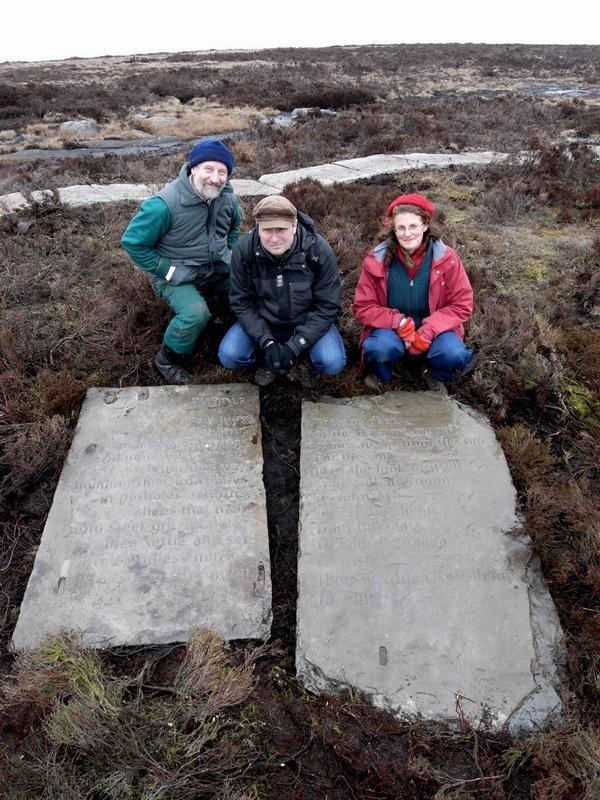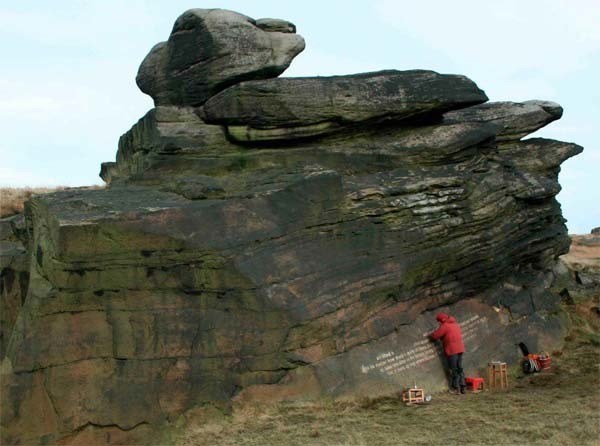Stanza Stones Poetry Seat

The cache, a small, screw-capped, camo-taped plastic pot, is hidden at this secluded, inspirational and literary resting place along the Stanza Stone (Poetry) Trail and (just off the) Stanzastones Walk high up on Rombald's Moor, some 80 m east of the Dalesway Link.
To reach the cache location:
a) from the Cow & Calf rocks car park: park @ N 53 54.981 W 1 48.028, the Cow & Calf parking lot. If full (eg. functions or Bank Holidays), you should be able to find off-road parking further up the road, or you may find space in the car park of the nearby pub.
Walk up the flagged path and then either i) climb up the Cow & Calf rocks by any one of several routes or ii) head around the eastern edge of the rocks to the plateau above.
Then if using i) take the trail starting around N 53 54.965 W 1 48.229 heading south-west or if using ii) take the trail starting around N 53 54.916 W 1 48.143 heading west-south-west. After some 300m both of these join.
*From this junction take either of the trails heading south either along the beck or parallel to the beck on the west side, to the junction @ N 53 54.779 W 1 48.435. From here head due south along the small trail to the cache location.
b) from the White Wells access path car park: park @ N 53 55.134 W 1 49.572 and follow the main trail up to White Wells, then continue on this climbing up behind (south of) White Wells following the Dales Way Link branching left onto Dales Way @ N 53 54.871 W 1 49.069. Continue up the wonderful Rocky Valley to the trails junction by the beck @ N 53 54.866 W 1 48.411.
From here head south, as in * above, to the cache location.
Stanza Stones Trail

In 2010 Ilkley Literature Festival and imove commissioned leading UK poet, Simon Armitage, to create a series of poems responding to the landscape of the Pennine Watershed in the run up to the London 2012 Olympic and Paralympic Games. The aim of the stones, part of the Pennine Watershed project, is to create a permanent legacy from the Games.
 Letter carver Pip Hall assisted by apprentice Wayne Hart was asked to carve Simon’s poems in six atmospheric locations along the Watershed from Marsden, where Simon was born, to Ilkley. Each stone took weeks to complete with Pip spending days out on the moors. The 47 mile trail took 18 months to create with the help of local expert and guide Tom Lonsdale.
Letter carver Pip Hall assisted by apprentice Wayne Hart was asked to carve Simon’s poems in six atmospheric locations along the Watershed from Marsden, where Simon was born, to Ilkley. Each stone took weeks to complete with Pip spending days out on the moors. The 47 mile trail took 18 months to create with the help of local expert and guide Tom Lonsdale.
At each end of the Trail, on Pule Hill and Ilkley Moor (where the cache is located), local dry stone waller Nick Ferguson created a Poetry Seat – where you can sit and admire the view or - if sufficiently inspired - to write your own poem, which you can place in the Poem Post Box there.
These initiatives were supported by a South Pennines rural regeneration company.
See here for a short documentary on the Stanza Stones project.
In a foreword to the Stanza Stones Trail Guide, the poet explains [with my annotations]:
'For many thousands of years people have been coming to moors around West Yorkshire to offer their prayers and express their desires in the form of carved stones [as evidenced by the numerous ancient stone carvings on Romabald's Moor].
The Stanza Stones poems are my contribution to that unbroken and ongoing dialogue, and consist of six carved poems sited across the South Pennine Watershed, all celebrating or paying their respects to the element which gave shape and form to this region, namely water. The water that sculpted the valleys, the water that powered the industries, the water we take for granted but which is our most precious life-giving substance.
Each carved poem describes water in one of its many forms, hence a Beck Stone [in Backstone Beck, above Ilkley], a Puddle Stone [near Whetstone Gate, top of Rombalds Moor], a Mist Stone [on Nab Hill near Oxenhope], a Rain Stone [at Cow’s Mouth Quarry off A58 Littleborough-Ripponden road] and a Dew Stone [on Rivock Edge, off the Silsden-East Morton road]. The Snow Stone, the first to be carved, is situated in an old quarry on Pule Hill above the village of Marsden where I was born and grew up. [See Gallery for location grid references and coordinates.]
 In my experience the moors are both brutal and blissful, an essential part of our ecology, economy, our vocabulary and our subconscious. So as well as being landmarks in their own right, I hope the Stanza Stones act as beacons of inspiration, encouraging people to engage with West Yorkshire and Lancashire’s great outdoors in thought, word and deed.
In my experience the moors are both brutal and blissful, an essential part of our ecology, economy, our vocabulary and our subconscious. So as well as being landmarks in their own right, I hope the Stanza Stones act as beacons of inspiration, encouraging people to engage with West Yorkshire and Lancashire’s great outdoors in thought, word and deed.
And those looking hard enough might stumble across a seventh Stanza Stone, a secret stone left in an unnamed location within the Watershed area, waiting to be discovered and read'. [Sadly, this stone is now truly hidden (for ever?) having been washed away from its original location during a flood!]
See here for a short video of Simon explaining about the motivation for the project and the poetry and here for a video of him reading the Beck Stone poem.
The trail can be done as a series of short family walks of <1 hour each, as 3 legs (Marsden - Hebden Bridge  (18.4 miles) - Bingley (14.5 miles) - Ilkley (14.1 miles), or as a challenging 47 mile hike. See here for a short video of the hike, done over 3 days with 2 nights tent and here for another covering hikes to the first three stones, with reading of the poems and related photos. See here for a video account of 'Walking The Line' where in October 2013 four poets walked the trail often joined by members of the public visiting the stones, reading the poems and then holding evening performances of their work and discussion of the walk. This culminated in a performance on the last evening of the annual Ilkley Literature Festival.
(18.4 miles) - Bingley (14.5 miles) - Ilkley (14.1 miles), or as a challenging 47 mile hike. See here for a short video of the hike, done over 3 days with 2 nights tent and here for another covering hikes to the first three stones, with reading of the poems and related photos. See here for a video account of 'Walking The Line' where in October 2013 four poets walked the trail often joined by members of the public visiting the stones, reading the poems and then holding evening performances of their work and discussion of the walk. This culminated in a performance on the last evening of the annual Ilkley Literature Festival.
A book titled 'Stanza Stones' is a record of the journey of creating the stones and trail containing the poems and accounts of the poet and letter carver.
Stanzastones Walk
See here for an alternative '50 mile Upland Walk' version of the trail with detailed information on the stones (including location coordinates), maps, photos and a comprehensive trail guide. This also has 3 stages: Marsden - Mytholmroyd (18.08 miles) - Haworth (17.38 miles) - Ilkley (20.6 miles).
 The Stanzastones Walk route is mostly different from the Stanza Stones Trail, enabling some circular options - day walks to visit each stone. The Walk has existed since 2011 when the last stone was completed. As much as possible It avoids well walked footpaths and better known routes such as The Pennine Way and The Millennium Way, but this was not always possible as there are some significant places of interest worth visiting on these long-distance walk sections (eg. Blackstone Edge). It was also motivated by literature and so visits places such as Haworth and Mytholmroyd which inspired some of the area's finest writers. The Trail team have no objection to the Walk or the web site
The Stanzastones Walk route is mostly different from the Stanza Stones Trail, enabling some circular options - day walks to visit each stone. The Walk has existed since 2011 when the last stone was completed. As much as possible It avoids well walked footpaths and better known routes such as The Pennine Way and The Millennium Way, but this was not always possible as there are some significant places of interest worth visiting on these long-distance walk sections (eg. Blackstone Edge). It was also motivated by literature and so visits places such as Haworth and Mytholmroyd which inspired some of the area's finest writers. The Trail team have no objection to the Walk or the web site